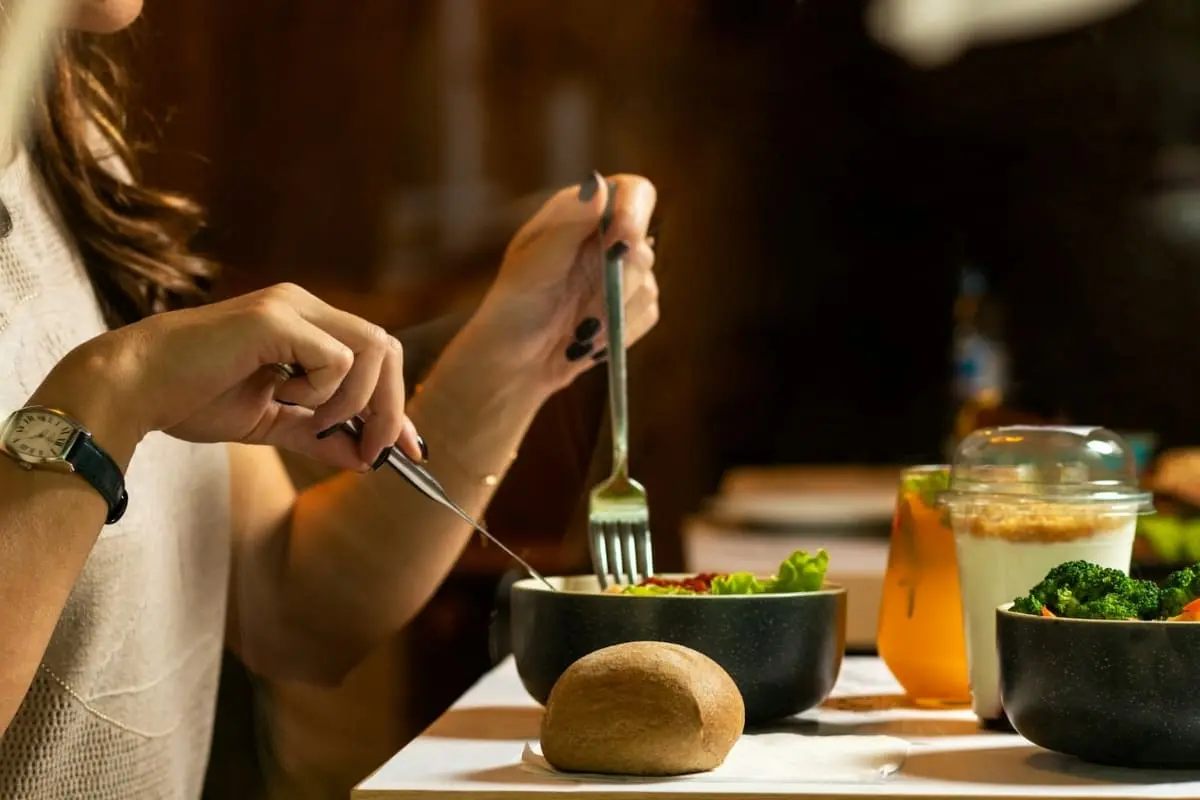Sauna After Eating: Why the Wrong Timing Could Ruin Your Experience

Key Takeaways:
- Wait 1.5-2 hours after eating before using a sauna
- Light, easily digestible foods are best before sauna sessions
- Avoid heavy, fatty, or spicy foods if planning to sauna
- Stay hydrated before, during, and after sauna use
- Listen to your body’s signals to find your personal sauna timing sweet spot
Sauna after eating can be tricky business for your body. Many people jump into the heat too soon after a meal, only to experience discomfort that ruins what should be a relaxing experience.
Understanding the right timing between eating and sauna use isn’t just about comfort—it affects how your body responds to heat and the benefits you receive from your session.
Table of Contents
MEDICAL DISCLAIMER: The information provided in this article is for educational purposes only and is not intended as medical advice. Always consult with a qualified healthcare professional before starting any new health regimen, including the use of saunas.
The Science Behind Digestion and Sauna Heat
When you eat a meal, your body diverts blood flow to your digestive system.
Research shows that after eating, blood flow increases substantially to your digestive organs, drawing a significant portion of cardiac output during active digestion.1
At the same time, sauna heat causes:
- Increased heart rate
- Expanded blood vessels in your skin
- More blood flowing to your body’s surface for cooling
These competing demands create a physiological challenge. Your body must choose between sending blood to digest food or to cool you down—it can’t efficiently do both at once.
During heat exposure, your body prioritizes cooling over digestion.2 This makes sense from a survival standpoint, but it’s why sauna sessions too soon after eating often cause discomfort.
How Long Should You Wait After Eating?
The ideal waiting period between eating and sauna use depends on several factors:
General recommendation: 1.5-2 hours after a meal. This timing allows for:
- Initial digestion to take place
- Blood flow demands to decrease
- Comfortable heat tolerance
The size and type of meal matters too. A heavy, fatty meal might require closer to 3 hours of waiting time, while a light snack might only need 1 hour.
Your body provides clear signals when you haven’t waited long enough:
- Feeling unusually hot
- Dizziness or lightheadedness
- Nausea or stomach discomfort
- Feeling sluggish or uncomfortable
Optimal Pre-Sauna Nutrition Strategies
What you eat before sauna sessions significantly impacts your experience. The goal is to provide energy without taxing your digestive system.
Best pre-sauna food choices:
- Fresh fruits (especially water-rich options like melons)
- Yogurt (plain, low-fat)
- Small portions of easily digestible carbohydrates (rice cakes, oatmeal)
- Vegetables (cucumber, celery)
Consuming about 30-60g of low-fiber carbohydrates about 90 minutes pre-sauna, similar to pre-exercise protocols, can help stabilize blood glucose during your session.
Foods to avoid before sauna:
- Heavy, fatty meals
- Spicy foods
- Large protein portions
- Alcohol
- Heavily processed foods
Hydration is just as important as food timing. Drink about 500mL of electrolyte-enhanced water (containing 40-60 mg/L sodium) about 60 minutes before your session to optimize plasma volume without causing stomach distress.3

What Happens If You Sauna Too Soon After Eating?
Using a sauna too soon after eating creates a perfect storm of competing physiological demands. Here’s what happens:
- Digestive disruption: Your body diverts blood away from your digestive tract to cool your skin, potentially slowing digestion.
- Cardiovascular strain: Your heart must work harder to pump blood to both your digestive organs and your skin.
- Discomfort symptoms: You may experience:
- Nausea
- Dizziness
- Stomach cramps
- Fatigue
- Overheating
- Reduced sauna benefits: The stress on your system might cancel out some relaxation benefits of the sauna.
The sauna experience is meant to be relaxing and therapeutic. Timing it wrong turns it into a stress on your body rather than a relief.
Post-Sauna Nutrition for Recovery
What you consume after sauna use is just as important as your pre-sauna strategy. Sweating depletes your body of fluids and electrolytes that need replacement.
Optimal post-sauna nutrition includes:
Hydration priorities:
- Replace 150% of lost fluid volume (due to ongoing losses) [Roca Rubio et al., 2021]
- Include electrolytes in your rehydration strategy [Meyer et al., 1992]:
- Sodium: 20-30 mEq/L (460-690 mg/L)
- Potassium: 2-5 mEq/L (78-195 mg/L)
- Magnesium: 10-20 mg/L
Food choices for recovery:
- Water-rich fruits and vegetables (melons, oranges, cucumbers, celery)
- Lightly salted foods to replace sodium (pretzels, rice cakes)
- Protein sources (20-40g within 30 minutes helps muscle recovery)
For athletes combining sauna with workouts, protein timing becomes even more critical. Consuming 0.3g/kg of whey protein within 30 minutes post-sauna may counteract stress-related cortisol elevations.
Creating Your Personal Sauna Timing Protocol
No two bodies respond exactly the same way to sauna heat or digestion. Creating a personalized approach means tracking what works best for you.
Tips for developing your timing strategy:
- Start conservatively: Begin with longer waiting periods (2+ hours) and gradually test shorter times.
- Keep a sauna journal: Track:
- What you ate
- How long you waited
- How you felt during the session
- Any symptoms you experienced
- Consider the time of day:
- Morning sauna sessions: Ensure you’re not hungry but not full from breakfast
- Afternoon sauna sessions: Often ideal as lunch is digested, but dinner hunger hasn’t started
- Evening sauna sessions: Wait 2+ hours after dinner for optimal comfort
- Adjust for sauna type:
- Traditional Finnish saunas (higher heat) may require longer waiting periods
- Infrared saunas or sauna blankets (gentler heat) might allow slightly shorter waiting times
Many sauna enthusiasts find their “sweet spot” timing through trial and error. Trust what your body tells you—discomfort is a clear signal that your timing needs adjustment.
Conclusion
Finding the right balance between eating and sauna use makes all the difference in your experience.
The 1.5-2 hour guideline works well for most people, but your body might have its own preferences. By paying attention to the types of foods you eat, staying properly hydrated, and allowing adequate digestion time, you’ll maximize the benefits of sauna after eating while avoiding uncomfortable side effects.
Remember that sauna sessions should feel good—if you’re experiencing discomfort, adjust your timing or pre-sauna nutrition. With these strategies, your sauna routine can become a truly rejuvenating practice that supports your overall wellness goals.
Resources
- Siebner, T. H., Fugl Madelung, C., Bendtsen, F., Løkkegaard, A., Hove, J. D., & Siebner, H. R. (2021). Postprandial Increase in Mesenteric Blood Flow is Attenuated in Parkinson’s Disease: A Dynamic PC-MRI Study. Journal of Parkinson’s disease, 11(2), 545–557. https://doi.org/10.3233/JPD-202341 ↩︎
- Crandall, C. G., & Wilson, T. E. (2015). Human cardiovascular responses to passive heat stress. Comprehensive Physiology, 5(1), 17–43. https://doi.org/10.1002/cphy.c140015 ↩︎
- Meyer, F., Bar-Or, O., MacDougall, D., & Heigenhauser, G. J. (1992). Sweat electrolyte loss during exercise in the heat: effects of gender and maturation. Medicine and science in sports and exercise, 24(7), 776–781. ↩︎

“Become a Sauna Expert Overnight!”
Grab Your “FREE” Sauna E-book NOW!
Get your hands on the ultimate sauna manual. From history to DIY setups, our free guide has it all.

As a Chartered Accountant turned sauna enthusiast, I bring a unique blend of analytical skills and hands-on experience to the world of heat therapy. With over a decade dedicated to researching and testing sauna products and practices, I’ve developed a deep understanding of this field. A the founder of HomeInDepth.com, I provide reliable, easy-to-understand information on all aspects of saunas. My goal is to guide you through every step of your sauna journey, offering meticulously researched, unbiased advice to help you make informed decisions and create your perfect sauna experience. I’m always happy to hear from sauna lovers like you—feel free to leave questions or share your own tips in the comments below so we can learn together. Contact me on:






